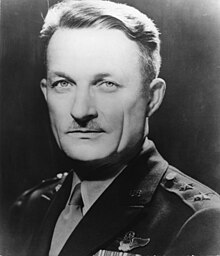St. Clair Streett | |
|---|---|
 Streett in the 1940s | |
| Nickname(s) | Bill[1] |
| Born | October 6, 1893 Washington, D.C. |
| Died | September 28, 1970 (aged 76) Andrews Air Force Base |
| Buried | |
| Allegiance | |
| Service | |
| Years of service | 1910–1952 |
| Rank | |
| Commands | 11th Bombardment Group Third Air Force Second Air Force Thirteenth Air Force Continental Air Forces[2] Strategic Air Command |
| Battles / wars | World War I World War II |
| Awards | Distinguished Flying Cross[3] Mackay Trophy Distinguished Service Medal (3)[4] Legion of Merit (2)[5] Purple Heart[3] Air Medal[6] |
St. Clair Streett (October 6, 1893 – September 28, 1970), known as "Bill", was a United States Air Force (USAF) major general and writer who first organized and led the Strategic Air Command (SAC).[2] Streett served as aide to air power advocate General Billy Mitchell, and was viewed by General of the Air Force Henry H. Arnold as his own personal "troubleshooter".[7]
Earlier in his career, Streett served in France during the last stages of World War I. In 1920, he was awarded the Mackay Trophy and the Distinguished Flying Cross for leading a squadron of U.S. airmen on a pioneering air voyage from New York City to Nome, Alaska and back. Streett wrote of his squadron's difficulties in an article for National Geographic. Streett assisted Mitchell during the famous bombing demonstration against battleships. After participating in several air races, he made an exploratory flight to extreme altitude during which he experienced frozen flight controls, and then wrote a story about the adventure for Popular Science.[8]
During World War II, Streett commanded various training units in Hawaii, Florida and Colorado, solving logistical, training, and personnel problems. In Washington, D.C., he led the Theater Group of the Operations Division in the Office of the Chief of Staff where he expressed grave misgivings about the role of General Douglas MacArthur in the Pacific War—some two years later Streett was sent to the South West Pacific Area to work under MacArthur commanding the Thirteenth Air Force during its first offensive drive.[4]
With victory certain, Streett returned to the United States to organize for Arnold the Continental Air Forces (CAF), and then to expand its operation across the country. Streett retained command when the CAF turned into the SAC, and continued to experience friction with MacArthur. After retiring from the United States Air Force in 1952, Streett was named to the Sarnoff Commission, a presidential formation tasked with trimming unnecessary military spending.[9]
- ^ Cite error: The named reference
Maurerwas invoked but never defined (see the help page). - ^ a b Cite error: The named reference
PlanningPostwarwas invoked but never defined (see the help page). - ^ a b Official Army Register, 1946. Page 662. "Streett, St. Clair" (O9619). Retrieved on November 22, 2009.
- ^ a b Cite error: The named reference
arlingtonwas invoked but never defined (see the help page). - ^ "Air Force Award Cards [Legion of Merit]". U.S. Archives and Records Administration. January 28, 1952. Retrieved October 26, 2024.
- ^ "Air Force Award Cards [Air Medal]". U.S. Archives and Records Administration. October 2, 1942. Retrieved October 26, 2024.
- ^ Cite error: The named reference
Marawas invoked but never defined (see the help page). - ^ Cite error: The named reference
PopularSciencewas invoked but never defined (see the help page). - ^ Cite error: The named reference
UPIwas invoked but never defined (see the help page).